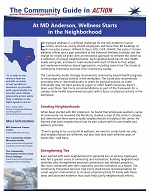At MD Anderson, Wellness Starts in the Neighborhood
Summary
 MD Anderson Cancer Center wanted to create an employee wellness program for the nearly 20,000 employees spread across its massive Houston campus. The center’s former wellness officer, William B. Baun, EPD, CWP, FAWHP, used evidence-based approaches from the Guide to Community Preventive Services to develop tailored wellness programs for each “neighborhood” on the campus. These programs included Be Well stations with workout equipment and social support interventions. Employee buy-in and neighborhood ownership made a big difference in creating culture change with a focus in employee wellness. (Released 2017)
MD Anderson Cancer Center wanted to create an employee wellness program for the nearly 20,000 employees spread across its massive Houston campus. The center’s former wellness officer, William B. Baun, EPD, CWP, FAWHP, used evidence-based approaches from the Guide to Community Preventive Services to develop tailored wellness programs for each “neighborhood” on the campus. These programs included Be Well stations with workout equipment and social support interventions. Employee buy-in and neighborhood ownership made a big difference in creating culture change with a focus in employee wellness. (Released 2017)
Lessons Learned
- Set up neighborhoods or divide people into smaller groups when the overall population is large, diverse, or geographically separated. Baun worked with neighborhoods to identify their health and wellness goals. He looked to The Community Guide for intervention approaches that could be expected to help neighborhoods achieve their goals, and adapted them to each group’s unique culture.
- Be creative in your approach and make health fun. One neighborhood decided to begin every meeting with a hula hooping activity.
- Employee buy-in and collective ownership can make some of the biggest differences. Culture changes that begin with middle management and individual employees are often more effective than those that are simply mandated by higher-level executives. Baun found that at MD Anderson, asking neighborhoods what was important to them was better than blanket strategies or a fitness center with expensive equipment.
Story
The Community Preventive Services Task Force (CPSTF) strongly recommends community-based health programs to encourage physical activity in the workplace. The CPSTF also recommends providing new or improved access to areas for physical activity, as some individuals may not have access to a gym or other health resources. Baun’s team used these CPSTF recommendations as part of the framework for a campus-wide health improvement project with a focus on physical activity in the workplace.
Creating Neighborhoods
When Baun started with MD Anderson, he found that employees wanted a sense of community. He reviewed the literature, studied a map of the center’s campus, and determined there were actually neighborhoods throughout the center. He learned that each neighborhood had its own culture with its own health and wellness priorities.
“If we’re going to be successful in wellness, we need to understand not only that neighborhoods are different, but also that they have different ways of ownership,” said Baun.
Strengthening Ties
Baun worked with each neighborhood to generate buy-in among employees who felt a greater sense of ownership and motivation. Building neighborhood identities also strengthened personal connections and allowed people to feel more connected with their coworkers and the institution as a whole. The CPSTF recommendation for social support interventions to increase physical activity fit nicely with these ideas and provided evidence that could help justify neighborhood efforts.
Be Well Stations
Based on the CPSTF recommendation for combining informational outreach with creating or enhancing access to physical activity stations, Baun worked with neighborhoods to create Be Well Stations with elliptical machines, scales, and stretch bands that employees could use between projects. Some neighborhoods took things even further by raising funds to install more elaborate fitness areas.
By creating access to places for physical activity and social interaction, the Be Well Stations provide employees a place to be active without straying too far from work. This ease of access combined with the community input promotes wellness on a daily basis.
On-Going Search for Evidence
Baun and his team followed developments from the CPSTF by regularly checking The Community Guide website and subscribing to emails about new findings. “From a program planner standpoint, I can’t imagine people not waiting for Task Force findings to come out so they can see what’s new,” Baun said. “For me, [it’s important] to be able to look at that literature and the findings.” Having access to information about the systematic review results and supporting materials allowed him to consider whether intervention approaches could be expected to work for MD Anderson.
More Information
Community Preventive Services Task Force findings referred to in this story:
The Community Guide: Physical Activity